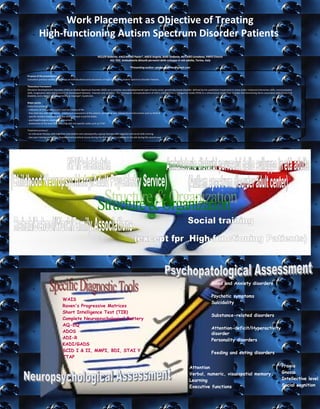Work placement as objective of treating high functioning autism spectrum disorder patients
- 1. Work Placement as Objective of Treating High-functioning Autism Spectrum Disorder Patients  KELLER Roberto, VACCARINO Paolo*, ARESI Angela, BARI Stefania, NOTARO Loredana, PIRFO Elvezio  ASL TO2, Ambulatorio disturbi pervasivi dello sviluppo in età  adulta, Torino, Italy *Presenting author: paolovaccarino@gmail.com Purpose of the presentation Evaluation protocol related to organize an individualized work placement of High-functioning Autism Spectrum Disorder Patients. Theoretical framework Pervasive Developmental Disorders (PDD) or Autism Spectrum Disorder (ASD) are a complex neurodevelopmental type of early-onset, genetically based disorder, defined by the qualitative impairment in many areas: reciprocal interaction skills, communication skills, imaginative skills and presence of stereotyped behavior, interests and activities. The nosological conceptualization of ASD is shifting from a categorical model (PDD) to a dimensional model that includes low-functioning forms associated with intellectual disability and a High-Functioning forms, as Asperger's Syndrome. Major points Evaluation protocol: - collection of clinical information and the history of life - free interview with the patient - intellectual assessment of the patient, conducted with standardized instruments such as WAIS-R - specific testistic evaluation with the ADOS module 4 and the GADS - psychopathological psychiatric assessment - assessment of the level of functioning with the specific scales such as TTAP Treatment protocol: - an individual therapy with cognitive intervention and subsequently a group therapy with cognitive and social skills training - two year training protocol: a theoretical and practical course during the first year and a training on the job during the second year WAIS Raven's Progressive Matrices Short Intelligence Test (TIB) Complete Neuropsychological Battery AQ-EQ ADOS ADI-R KADI/GADS SCID I & II, MMPI, BDI, STAI Y TTAP Attention Verbal, numeric, visuospatial memory Learning Executive functions Mood and Anxiety disorders Psychotic symptoms Suicidality Substance-related disorders Attention-deficit/Hyperactivity disorder Personality disorders Feeding and eating disorders Praxia Gnosia Intellective level Social cognition
- 2. 1) diagnosis and resource activation1) diagnosis and resource activation 2) individual therapy2) individual therapy 3) cognitive interventiom in small group with Feuerstein Method Training3) cognitive interventiom in small group with Feuerstein Method Training 4) social skill training in small group4) social skill training in small group 5) pre-work training at school5) pre-work training at school 6) attendance at specific rehabilitation centers6) attendance at specific rehabilitation centers 7) meeting with family7) meeting with family 8) meeting with care-givers network8) meeting with care-givers network ReferencesReferences Keller R., Bugiani S., Fantin P., Pirfo E.Keller R., Bugiani S., Fantin P., Pirfo E. Neuroni specchio e autismo Mirror neurons and autism.Neuroni specchio e autismo Mirror neurons and autism. Journal of PsychopathologyJournal of Psychopathology 2011;2011;1717:404-412:404-412 Cauda F., Geda E., Sacco K., D’Agata F., Duca S., Geminiani G., Keller R.Cauda F., Geda E., Sacco K., D’Agata F., Duca S., Geminiani G., Keller R. Grey matter abnormality in autism spectrum disorder: an activation likelihood estimation meta-analysis study.Grey matter abnormality in autism spectrum disorder: an activation likelihood estimation meta-analysis study. Journal of Neurology, Neurosurgery and PsychiatryJournal of Neurology, Neurosurgery and Psychiatry 2011;2011;8282:1304-1313:1304-1313


